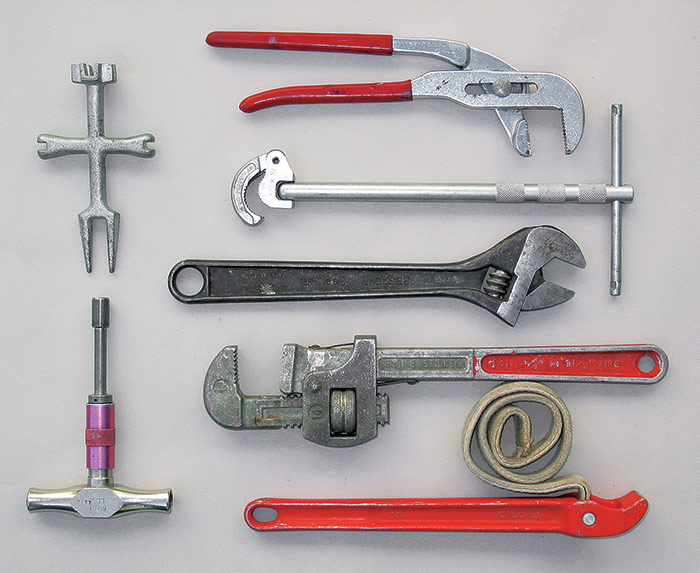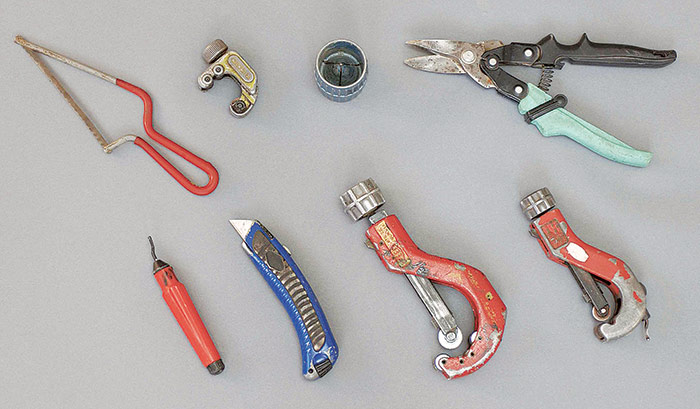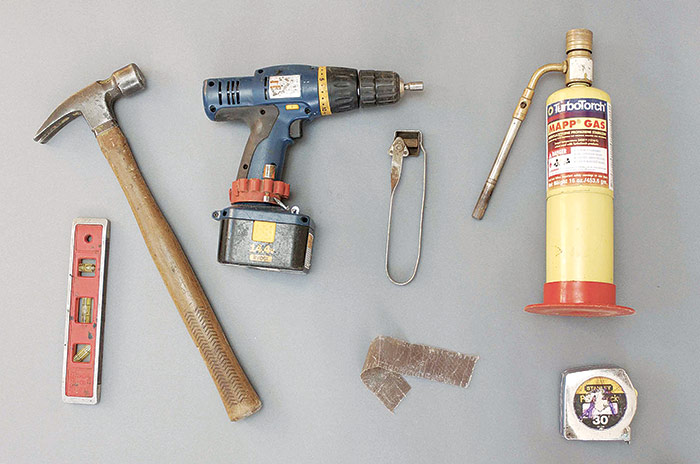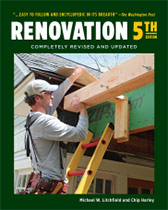Essential Plumbing Tools
Installing water lines, drain pipes, and plumbing fixtures often requires specialty tools, but fortunately most of these are affordable and easy to use.

In a pinch, you can sometimes tackle basic plumbing repairs with common household tools, but to do the job right it usually takes wrenches and cutting tools that are made for the task at hand. Here’s an overview of some of the most common plumbing tools and what jobs they are used for.
Wrenches and Pliers

Pipe wrenches tighten and loosen threaded metal joints, such as 3⁄4-in. nipples (short pipe lengths) screwed into a water heater, galvanized pipe unions, and so on. A pair of 10-in. or 12-in. pipe wrenches should handle most tasks. Get two: Most of the time, you’ll need one wrench to hold the pipe and the other to turn the fitting.
Adjustable wrenches (also called Crescent wrenches) have smooth jaws that grip but won’t mar chrome nuts and faucet trim. Get several: A 4-in. adjustable wrench is right for the closet bolts that anchor toilet bowls, a 12-in. wrench gives extra leverage for stubborn nuts, and an 8-in. wrench is appropriate for almost everything else.
Strap wrenches aren’t a must-have tool but are useful when you need to grip polished pipe without scarring it.
Slide-nut (sliding-jaw) pliers are good utility tools for holding nuts, loosening pipe stubs, and holding a pipe section while it’s being soldered.
Locking pliers (or Vise-Grip pliers) adjust and clamp down on fittings, for example, so you can have both hands free to hold a torch and apply solder.
Basin wrenches are about the only tools that can reach water-supply nuts on the underside of sinks and lavs, where supply pipes attach to threaded faucet stems.
Tub-strainer wrenches tighten tub strainer and tailpiece assemblies.
No-hub torque wrenches tighten stainless-steel band clamps on no-hub couplings. Many plumbers use a cordless drill/driver to do most of the tightening, but code requires that final tightening be done by hand.
Cutting and Reaming Tools

Pipe cutters (also called wheeled tubing cutters) are the best tools for a clean, square cut on copper pipe. Tighten the cutter so that its cutting wheel barely scores the pipe, then rotate the tool around the pipe, gradually tightening until the cut is complete. Many types have a foldaway deburring tool. Use a close-quarters cutter (thumb cutter) where there’s no room for a full-size one. If you’re installing CPVC plastic supply pipe, use tubing shears for clean, quick cuts. A hacksaw works but not as well.
A reaming tool (if your cutter doesn’t have one attached) is used to clean metal burrs after cutting copper. Use a round wire brush to polish the inside of copper fittings after reaming and plumber’s sand cloth to polish the pipe ends. If you’re cutting plastic pipe, use a rounded file to remove burrs—the steel jaws of an adjustable wrench also work well for deburring plastic pipe.
Wide-roll pipe cutters open wide to receive the larger diameters of plastic DWV pipe. Plastic-pipe saws have fine teeth that cut ABS and PVC pipe cleanly—and squarely, if used with a miter box. If you need to cut into cast iron, rent a snap cutter, also known as a cast-iron cutter. It’s the only tool that cuts cast iron easily. Some models have ratchet heads for working in confined places.
Miscellaneous Tools

A cordless drill and a cordless reciprocating saw are must-haves if you’re working around metal pipes that could become energized by electricity and when working in tight, often damp crawlspaces. Old lumber can be hard stuff to drill or cut, so 14.4v cordless tools are minimal. Cordless drills are perfect for attaching plumber’s strap, drilling holes in laminate countertops,
and so on.
If you need to drill 2-in. (or bigger) holes, use a heavy-duty right-angle drill. Large holes take sustained power and more torque than most cordless drills have, plus the long handles on a 1/2-in. right angle drill give you more leverage to prevent the drill from spinning out of your hands, which could cause injuries or damage.
Propylene or MAPP gas torches are somewhat more expensive than the propane torches popular with do-it-yourselfers. Either type of torch can solder the 1⁄2-in. or 3⁄4-in. fittings required for copper pipes, but propylene, being hotter, will do the job faster. That’s especially true if there’s a small amount of water left in a pipe.
Nonasbestos flame shields protect wood framing when soldering joints. It is also important to have a fire extinguisher nearby.
Your plumbing kit should also include a handful of other tools. Aviation snips are used for cutting perforated strap and trimming gaskets, and a torpedo level helps with leveling stub-outs (pipe stubs protruding into a room), sinks, and toilet bowls. You’ll also want a hacksaw, screwdriver with interchangeable magnetic bits, utility knife, and a hammer.

Excerpted from Renovation, 5th Edition (The Taunton Press, 2019) by Michael Litchfield and Chip Harley
Available at Amazon.com.





